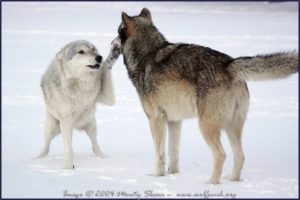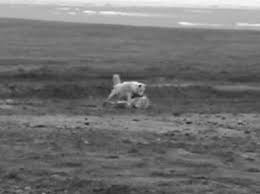Fight or Flight – How do dogs decide?
 Fight or flight, how do dogs decide? If a dog is in a fearful or anxious state of mind, he has three options if he is uncomfortable with the situation. He can flee, he can stand his ground and fight or he can avoid. There is a fourth ‘freeze’ but that could possibly also be standing his ground, ready to fight. The chosen option will surely determine how the dog’s body language will be displayed.
Fight or flight, how do dogs decide? If a dog is in a fearful or anxious state of mind, he has three options if he is uncomfortable with the situation. He can flee, he can stand his ground and fight or he can avoid. There is a fourth ‘freeze’ but that could possibly also be standing his ground, ready to fight. The chosen option will surely determine how the dog’s body language will be displayed.
Fearful aggressive may deter the aggressor
Most dogs who are cornered, will use the option to show aggression, albeit fearful aggression. It may be enough to deter a dog about to attack if he sees his quarry is fearful but willing to fight if necessary. So probably a cornered fearful dog will display ears back, head and body low, arched back, growling and snarling, tail low, pupils dilated. But it will still be seen by the prospective attacker, as an aggressive stance. If the fearful dog sees an escape route, he will take it. The attacker may give him that chance, to avoid getting bitten.
Fearful submissive
On the other hand, if the fearful dog already has an escape route he will more often than not choose that option. But there is another option. The fearful dog may really want to get to know the dog coming towards him with a dominant stance. He is a friendly dog and wants to be friends with this dominant and prospective ally. This is probably when the fearful dog will crouch down and make himself look unthreatening. He will display licking of lips, a tendency to turn over or lie sideways, often urinating. His ears will still be back and he may display teeth, perhaps chattering teeth. But the dominant dog knows this stance ensures he will not be attacked. He knows the submissive dog is saying “Ok, I know you’re the boss” or “I’m really friendly” or even “can I be your friend”.
 Dominant and submissive wolves
Dominant and submissive wolves
Have a look at this image, two wolves, one dominant and one submissive. The dominant wolf has his tail high and his ears forward. The subordinate wolf shows a lowered body, ears back, a submissive grin and puts up a submissive paw. Perhaps you’ve noticed either of these communications in your dog?
Different scenarios, different displays
So perhaps the same fearful anxious dog, can display different submissive behaviours, depending on the scenario.
Prolonged intensive dominance behaviour
I read with interest an article about a particular dominant behaviour filmed serendipitously by David Mech and Dean Cluff called – Prolonged Intensive Dominance Behavior Between Gray Wolves, Canis lupus. This clearly shows the stances of a submissive and a dominant dog.
They were filming in the High Arctic, near Eureka, Nanavut, Canada when they came across an unusual example of submissive and aggressive behaviour between 2 gray wolves. It was a 6.5 minute display of an adult male pinning down another male member of his pack. It was thought the other male was a maturing son of the adult.
 Pinned down for over 6 minutes
Pinned down for over 6 minutes
There are 6 pictures of the two males, here is just one of them. Not a brilliant picture I know, but the dominant breeding male wolf can be seen standing over the subordinate younger male. The alpha male wolf kept the underling on the ground for a total of 6.5 minutes.
Alpha male recovering from drugs?
It was interesting to note that the 40.5 kg dominant wolf had just been tagged with a radio collar after being darted at 1600 hrs on 8th July 2009. It was assumed that he had fully recovered from the drug as the incident happened later on in the day at 1930 hrs. But whose to know? Perhaps he had a dreadful headache and was a little crotchety after his ordeal and took it out on another wolf? Perhaps that’s why the behaviour was so prolonged?
It is quite unusual for a subordinate to be on his back for such a long period of time. Usually, the dominant dog will leave after the subordinant shows his respect by keeping still and staying in this submissive pose for a while, even after the alpha male has departed.

Wow I never knew about the sideways lying and urinating, and to think all this while I thought my dog is the big boss of all dogs lol. Fearful submissive is something not really pleasant to witness but I think it’s important for all dog lovers to know to understand their dog behaviours better as it shows how much we care, wouldn’t you agree
Hi there Riaz and thanks for your input. You’re right. I also think all owners should take a course to learn how their dogs tick. Once you know what they’re saying, it is quite fascinating to watch their language and interpret why they are exhibiting a certain behaviour.
Hello Ches, I must say that this article is very helpful and informative. I have two dogs which are not dangerous at all but just like you mentioned when they feel danger or fear they can be very aggressive and they can’t control themselves. Thank you for sharing such a great story, I definitely learned something new today.
Hi Daniel and thanks for the comment. You obviously care much for your dogs. It is so illuminating when you understand what they are saying. Remember, unlike us, dogs don’t lie, in fact they can’t lie, their communication and responses are in their DNA!
A really informative article about dog and wolf behavior. Social behavior of animals is a huge area of study of its own. There is a whisperer for just about any animal: dog whisperer, cat whisperer, dolphin whisperer, etc.
Wow, do dogs really urinate when they roll over in a submissive stance? I never knew that.
I also almost died at the submissive paw part.
Hi Mikhail and thanks for your input. Yes, it can take a while to work out what your dogs are saying and animal behaviour is a subject of its own. Dogs don’t always urinate when on their backs and being submissive, but many do. Unfortunately, most owners think the dog is doing it on purpose! The dog then get chastised and the problem just gets worse.
It is however, a natural response, so if your dog urinates on you, it is a sign of submission, fearfulness and/or overwhelming exitement. You need to work out which it is. Over-exitement is very common, when you return home for instance. How to stop it? Just ignore your dog when you come home, until he has got over the excitement. No touch, no talk, no eye contact until he has settled down, then you can fuss him as long as he is no longer excited.
Thank you for the insight. My friend’s dog has a very submissive behavior. He tend to give up when people around him do a small friendly prank. When he was introduced to a new friendly dog, he shows the same behaviors that you explained above. He try to looks friendly and both of the dogs become friends very fast! It’s amazing to observe and learn the behavior of dogs.
Hi Alblue, yes it is amazing to see how dogs become friends nigh on immediately, especially if they are both submissive or one is more submissive than the other. Problems occur when two dogs are on equal par, especially equally dominant, then you could have a problem.
For those wanting to get a second dog, always look for one that is more submissive than the dog you already have. The new dog will then be subordinate to the established dog and they will usually become the best of friends, each knowing their place. Remember, dogs do not know about equality, they know about hierarchy and are happy when they know where they are in the ‘pecking order’.